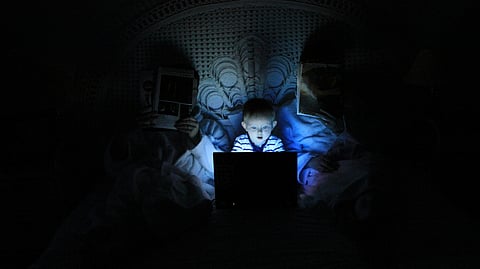Set a no-screen time: Excessive use of the screen before bed has been the main cause of exposure to light at night. Set a time to switch off all the gadgets at least 2 hours before going to bed. 2 hours is the sweet spot because, this time, you are more prone to phase (sleep) delay.
Dim lights or pitch dark: We commonly use LED lights today. But they are major emitters of blue light, the type known to suppress melatonin production. Switch off any bright white lights and use dimmer lights if needed. It is always best to sleep in a pitch-dark room, as now your eyes have nothing to do except be shut for sleep.
Use screens wisely: Let's be honest. Today we need to sit in front of screens for work. Using screens has become mandatory, more than just for pleasure. So use it wisely to protect your rhythm. Put your gadgets in night mode, dim the brightness, or use blue light filters, as suggested by experts. There are even apps like Redshift and Darkreader that can adjust your screen's color temperature and light mode.
It is okay to nap: We know daytime naps can lead to obesity and cardiovascular diseases. But that is less likely if your nap is shorter than 30 minutes. [10] Having a short nap during the day is important to reduce sleep pressure. Sleep pressure builds up when you prolong your sleep time since waking up. This can lead to fatigue, further disrupting your circadian rhythm and night sleep. Hence, a short nap of not more than 30 minutes can prevent this.
Mind your dinner: What you eat and when you eat dinner matter. Eating heavy meals late at night can disrupt your circadian rhythm. Experts advise having your dinner 2 to 4 hours before bedtime. Avoid a heavy dinner close to bedtime. So that your sleep isn’t affected and you aren’t tempted to switch on the lights or pick up your phones. Also, this can stabilize your glucose levels before sleep. But if you are hungry, it is okay to take a light, healthy bedtime snack. [9]
Consistent bedtime routine: To help the body maintain its circadian rhythm, try to go to bed and wake up every day at the same time, even on holidays.
For the shift workers: Taking care of your natural rhythm is not easy for shift workers. Some actions that they can take are:
Prioritize sleep over other work post their shift. Sleep as long as possible.
Take advantage of the breaks they get during the shift to have a short nap.
Do not over-commit with unnecessary work, both at home and at work.
If you are on a night shift, try to avoid bright light exposure in the second half of the night so that it is easier to sleep as soon as you get home.
Always have a prepared environment with minimal light and distractions to sleep.
Employers and organizations also play a huge role in maintaining the work-life balance of night-shift workers.
Other lifestyle shifts: There are a few lifestyle recommendations that ensure that your circadian rhythm is regulated. They are:
Avoid caffeine 5 hours before the planned sleep time.
Exercise can regulate your system. But avoid doing it 3 hours before sleep.
Avoid alcohol.
Get your insomnia treated soon. Approach a healthcare provider to seek help.


